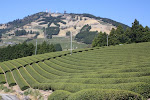From the beginning of this week, Shizuoka prefecture, where our teas come from, has been very cold. And on March 30, the temperature of the tea fields dropped to below freezing, and buds were largely affected by it. This doesn't influence tea quality, but the harvest date might be slightly delayed.
Recently, my father, Tea Maestro Sugimoto, has visited to his tea farmers very often. He makes sure that each tea plant grows their buds with energy and talks with his farmers about this year's harvest. Tea farmers are diligently taking care of their tea fields. Soon, tea fields will change their color to brilliant green.
In Japan, there are many tea producing regions. Well-known regions are Kagoshima, Fukuoka, Mie, Kyoto, and Shizuoka. Just like a wine, every regions have different taste characteristics, and each region is equally respected by people. Shincha harvest will begin from South region of Japan. So, Kagoshima is usually the first; the last year, they began the harvest from the end of March. And Fukuoka, Mie, Kyoto and Shizuoka are following.


 My mother, Kazue Sugimoto, has 15-year experience as Temomi technician. In 1995, she started making Temomi Cha just for her enjoyment, but now she recognized importance to preserve this traditional craft art for the next generation. She is very pleased to have this opportunity to present Temomi Shincha to American tea lovers.
My mother, Kazue Sugimoto, has 15-year experience as Temomi technician. In 1995, she started making Temomi Cha just for her enjoyment, but now she recognized importance to preserve this traditional craft art for the next generation. She is very pleased to have this opportunity to present Temomi Shincha to American tea lovers.






